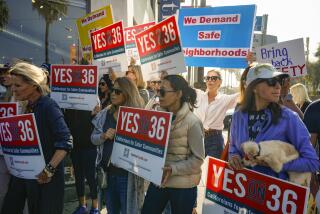Legal Fees: No on 106
- Share via
Of the world’s industrial nations, only the United States allows attorneys to charge contingency fees. Elsewhere, the idea that an attorney’s earnings might depend on whether his client wins--and how much the client wins--is regarded as unethical, almost shocking. Yet, in the United States, contingency fees have opened the courts to ordinary Americans who could never afford to pay an attorney by the hour but need redress for injuries caused by careless drivers or unsafe products. If the plaintiff wins, typically he pays his attorney 33% to 40% of the recovery; if he loses, both he and his attorney go away empty-handed.
This system, despite occasionally excessive fees, generally has served consumers well and contributed to the development of new areas of jurisprudence. As Ralph Nader has noted, “The contingent fee has allowed thousands of Americans to prevail against drunk drivers and manufacturers of asbestos, hazardous household products and Pinto fuel tanks.” Such suits not only provide justice for individuals, Nader added, but also “make companies pay more attention to their safety obligations toward all Americans.”
Yet now, in Proposition 106, California voters are being urged to put strict limits on attorneys’ contingency fees; under the initiative, plaintiffs’ attorneys could collect only 25% of the first $50,000 recovered by their clients, 15% of the next $50,000 and 10% of any amount above $100,000. This initiative, the work of the insurance industry, is supposedly designed to shift money from the pockets of trial lawyers to their clients, the injured parties. In fact, we fear, it would make it so unprofitable for lawyers to pursue complex, time-consuming cases that some plaintiffs would be denied legal services and some cases would never be filed at all.
Although Proposition 106 is part of the intimidating package of insurance-reform measuresthat confronts voters, it would do little or nothing to reduce insurance costs. Most auto-insurance claims already are settled for less than $50,000, typically with a 25% contingency fee--the same standard that Proposition 106 would impose. And there is nothing in this initiative to curtail the fraud rings that concoct automobile accidents and file nuisance cases, often with the connivance of dishonest attorneys and physicians; an attorney in such a case could still collect a 25% fee, enough to make it worth his while. Even two of the state’sleading insurance companies, State Farm and the Automobile Club of Southern California, have acknowledged that capping attorneys’ fees would be unlikely to reduce insurance premiums and have refused to follow the rest of the industry in financing Proposition 106.
Ironically, Proposition 106 would be more likely to discourage the most important lawsuits on the docket--those involving truly catastrophic injuries, novel legal theories or harm to huge classes of people. Lawyers may spend years investigating and litigating cases on the cutting edge of tort law, investing their own money without any assurance of recovery. To middle-income Americans, the $330,000 to $400,000 that an attorney clears on a $1-million judgment may seem overly generous, but that may reflect five to 10 years’ work; under Proposition 106, the contingency fee on a $1-million judgment would be limited to $110,000--so little that some personal-injury attorneys say that they would switch to other fields of law.
Proponents of Proposition 106 dismiss the possibility that plaintiffs with worthy cases would not find lawyers willing to handle them, but, at the same time, one of their major contentions is that this measure would lighten the courts’ caseloads. It seems to us, however, that those arguments are contradictory and obscure the real purpose of Proposition 106--to punish attorneys and to raise barriers to some consumers’ suits.
Despite our opposition to Proposition 106, we recognize that the contingency-fee system has its faults. Plaintiffs sometimes are forced to accept percentages that are clearly excessive, given the little time and effort required on the part of lawyers. Discipline by the organized Bar, the only recourse available to a client who believes that his attorney has overcharged him, can be lax. Some limits on contingency fees may be advisable; four other states already cap such fees, with good results, and since 1975 California has regulated fees in medical-malpractice cases. But all these laws are fairer to attorneys, and ultimately to consumers, than Proposition 106 would be; the scale in California’s medical-malpractice cases allows up to 40% for the first $50,000 recovered, 33% for the next $50,000 and so on. Because the contingency-fee limits in Proposition 106 would be the lowest in the nation and would deny Californians access to the courts, we urge a No vote.
More to Read
Inside the business of entertainment
The Wide Shot brings you news, analysis and insights on everything from streaming wars to production — and what it all means for the future.
You may occasionally receive promotional content from the Los Angeles Times.










